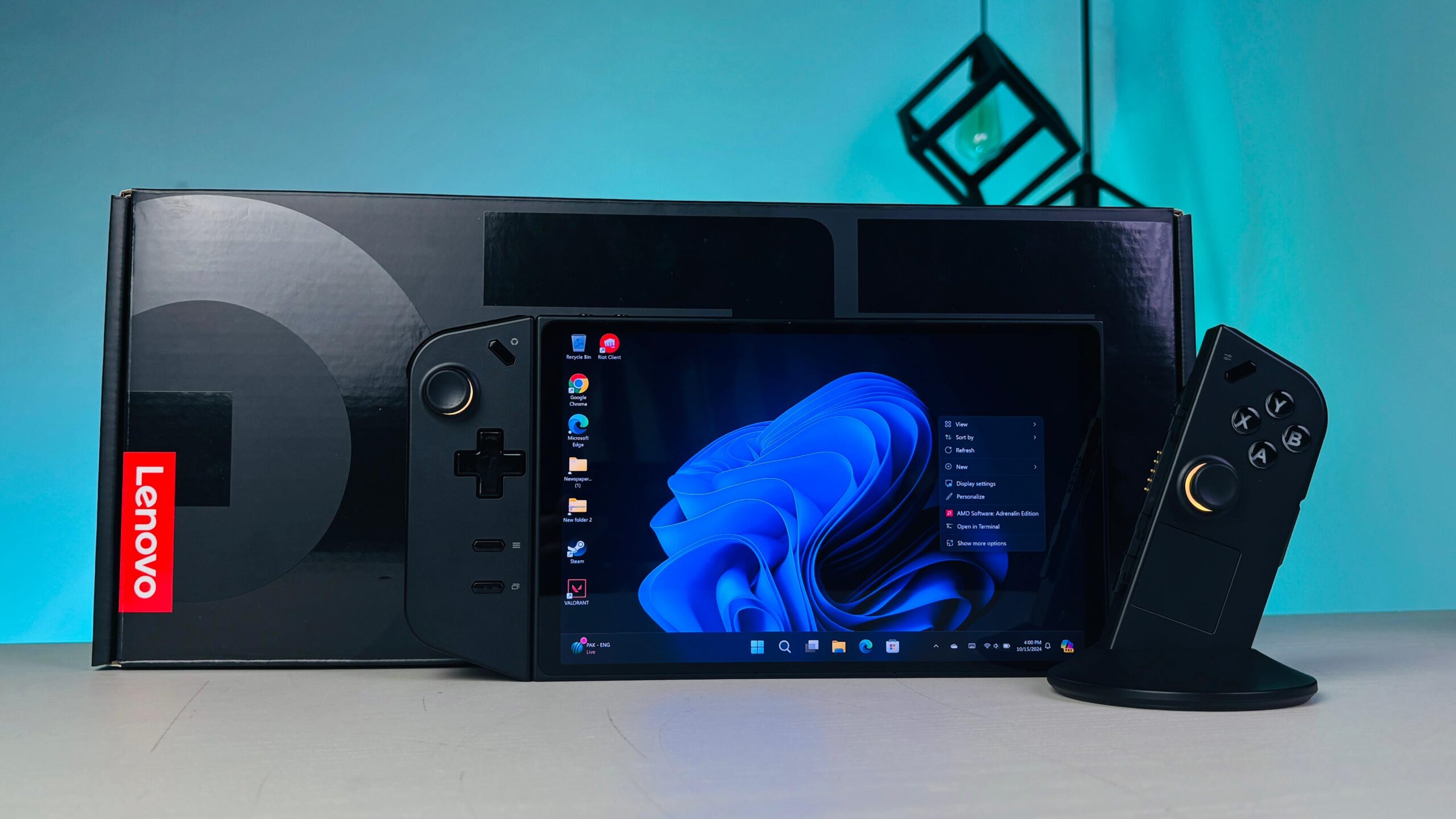
After putting the Lenovo Legion Go through its paces over the last few days, I can confidently say this is one of the most impressive handheld gaming PCs to hit the market this year. Competing with the likes of the Steam Deck OLED and the Asus ROG Ally, Lenovo’s first foray into handheld gaming offers a lot for those seeking a high-end experience. Sporting an 8.8-inch Quad HD+ IPS display, the latest AMD Ryzen Z1 Extreme chipset, and detachable TrueStrike controllers, the Legion Go certainly stands out. But how does it hold up under real-world use? Let’s dive into the details.
Unboxing and First Impressions

Right out of the box, the Legion Go feels like a premium device. It comes neatly packed inside a durable carry case, which will be useful if you plan on taking this monster on the road. The case can snugly fit the console, although you’ll need to carry the power adapter separately since it doesn’t fit inside. It also includes a base for transforming one of the controllers into a joystick, a neat addition for first-person shooter (FPS) fans.

At nearly 850 grams, the Legion Go is lighter than I expected, especially given its large size. Compared to the Steam Deck, it’s larger but surprisingly not as heavy as it looks. That said, if you’re planning on long gaming sessions, you may find your biceps aching after a while. And trust me, if you drop this on your face during an overhead session, you might be spitting out teeth! Still, the ergonomics are solid. I didn’t experience any hand cramps, even after hours of continuous gaming. Lenovo has done a fantastic job balancing the weight and designing the TrueStrike controllers for comfortable long-term use.
Design and Display

The Legion Go’s 8.8-inch Quad HD+ display is the device’s highlight. While it lacks the OLED screen tech that you’ll find on the Steam Deck OLED, the IPS panel still offers decent contrast with a resolution of 1600p. Lenovo also included a Radeon Super Resolution feature that upscales lower-resolution games, giving a visual boost without sacrificing too much performance. However, if you’re hoping for those deep blacks and vibrant colors OLED is known for, you might be slightly disappointed.

Despite the screen’s strengths, it only comes with Gorilla Glass 5 protection, not the newer Victus 2, so you might want to invest in a screen protector if you’re clumsy like me. As for color options, black is your only choice. It has the typical gaming aesthetic, complete with customizable RGB lighting around the thumbsticks and a glowing power button that changes color depending on your performance mode—an elegant touch.

The 8.8-inch IPS touchscreen offers a max 144Hz refresh rate, outperforming many other handhelds, including the ROG Ally. That said, you’ll only hit these high frame rates with less graphically demanding titles or when the device is plugged in and running at full performance. The display also maxes out at 500 nits brightness, which was enough for indoor gaming, but in dimmer scenes (like in Dead Space), I found myself cranking the in-game brightness just to see what was going on.
Performance and Software

Under the hood, the Legion Go runs on Windows 11, which, while offering great flexibility with game compatibility, does come with its quirks. I experienced the occasional Windows glitch, like pop-up messages minimizing my games, but these were more of an annoyance than a dealbreaker.
Where the Legion Go excels is in its Legion Space app, which consolidates all your games into one place. This interface makes it easy to jump between Steam, Epic Games, Xbox Game Pass, and even Amazon Appstore titles via its Android emulator. One feature that sets it apart from the Steam Deck is the ability to access titles from multiple game stores, although I did run into occasional issues with older games that lacked controller support.
Storage isn’t a concern either, thanks to 1TB of NVMe M.2 SSD storage and expandable memory via a microSD card. Whether you’re downloading AAA games or emulators, you’ll have plenty of space.
Performance in Games

Powered by the AMD Ryzen Z1 Extreme chipset (the same one found in the ROG Ally), the Legion Go delivers strong gaming performance. 16GB of RAM ensures that most modern titles run smoothly. In my testing, I played the Dead Space remake and Forza Horizon 5, pushing the device to its limits.
When plugged in, the Legion Go handled Dead Space at 1600p resolution with no major issues, though there were occasional stutters. With Forza Horizon 5, the device ran at 66 frames per second on 1080p with low settings, dropping slightly when I upped the resolution and graphics quality. Doom Eternal, however, was a bit finicky and refused to run smoothly unless I dropped the resolution to 1280×800.
The biggest downside comes when gaming on battery power. Performance drops drastically when the Legion Go isn’t plugged in. In Dead Space, the game became borderline unplayable until I lowered the resolution to 800p and reduced the refresh rate to 60Hz. Forza Horizon 5 showed similar struggles, forcing me to lower the settings significantly to maintain fluid gameplay.
Controllers and Unique Features

The TrueStrike controllers are a standout feature of the Legion Go. They are easy to detach, offering versatile control setups, especially with the integrated kickstand that lets you rest the console on a flat surface. The hall effect joysticks ensure no drift over time, and the triggers and buttons are responsive. For FPS enthusiasts, the FPS mode turns the right controller into a joystick-like mouse, improving precision, though it’s best used at a desk.
I also liked the inclusion of a scroll wheel on the right controller, which initially seemed odd but ended up being quite handy for certain in-game functions. Additionally, the Legion Space app lets you customize everything from vibration intensity to button mapping, making it easy to tweak the controls to your preferences.

The Legion Go features dual 2-watt stereo speakers, positioned near the top. The sound is loud and clear, though I wish the speakers were more front-facing, as they disperse sound more around the room than directly at you. However, they still provide an immersive experience in most games.
Cooling and Noise

The Legion Go features an advanced cooling system with a 79-blade liquid crystal polymer fan. On quiet mode, the fan is barely noticeable, but you’ll need to crank it up for more demanding games, at which point it can get quite loud. If you’re planning on gaming in bed next to someone, they may not appreciate the noise!

Lenovo managed to fit a 49.2Wh battery inside the Legion Go, but unfortunately, it doesn’t last as long as I had hoped. Playing Dead Space at 800p drained the battery in about 90 minutes on high-performance settings. Charging the device takes around the same amount of time when it’s powered off. While it’s not ideal for long trips without access to an outlet, the Legion Go does charge relatively quickly.
Portability is another challenge due to its sheer size. While the carry case is a nice addition, this is not a device you can easily slip into a small bag or backpack. It’s designed for serious gamers who prioritize performance over convenience.
Connectivity and Ports

Lenovo didn’t skimp on connectivity. The Legion Go is equipped with two USB-C 4 ports (both supporting Thunderbolt 4), a DisplayPort 1.4, and a microSD card slot for expanded storage. There’s also a 3.5mm headphone jack and full Bluetooth support, making it compatible with a wide range of gaming accessories.
Vent placement is excellent. Heat is expelled through vents on the top and back of the device, keeping your hands cool even during intensive gaming sessions. You won’t have to worry about hot air blowing on your fingers, which is a major plus.
Final Thoughts

So, should you buy the Lenovo Legion Go? That largely depends on your priorities. If you’re after a powerful gaming handheld with a large display, customizable controls, and the ability to access games across multiple platforms, the Legion Go is an excellent choice. However, its bulk, battery performance, and occasional Windows-related issues mean it’s not without its drawbacks.
For those seeking a more portable or budget-friendly option, the Steam Deck or Asus ROG Ally might be better suited to your needs. But if you’re willing to embrace its size and power, the Legion Go offers a fantastic gaming experience—just make sure you have a charger handy.


















